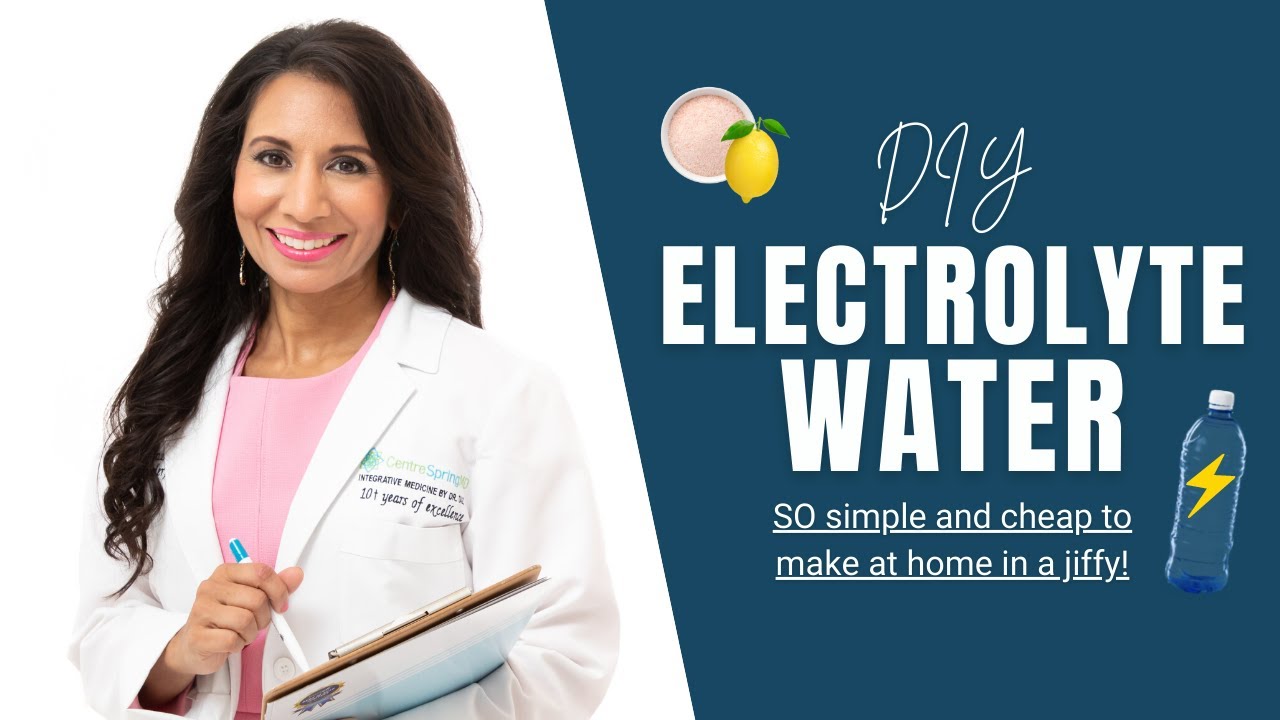DO IT YOURSELF-ELECTROLYTES

Please note our content is intended solely for informational purposes and should not be used in place of official medical advice.
What are Electrolytes?
Electrolytes are substances that have a natural positive or negative electrical charge when dissolved in water. An adult's body is about 60% water, which means nearly every fluid and cell in your body contains electrolytes. They help your body regulate chemical reactions, maintain the balance between fluids inside and outside your cells, and more.
Your body gets electrolytes or their components from what you eat and drink. Your kidneys filter excess electrolytes out of your body and into your urine. You also lose electrolytes when you sweat.
What do electrolytes do?
Your cells use electrolytes to conduct electrical charges, which is how your muscles contract. Those same electrical charges also help with chemical reactions, especially when it comes to hydration and the balance of fluids inside and outside of cells.
The key principle that electrolytes rely on is that certain chemical elements can naturally hold a positive or a negative electrical charge. When those elements are dissolved in a liquid, that liquid can then conduct electricity.
An example of this is salt water, which conducts electricity easily. Salt consists of sodium (positively charged) and chlorine (negatively charged), and when combined, their charges balance each other out. Atoms with an electrical charge are called ions (positive ions are called cations, while negative ions are called anions).
Dissolving salt in water splits the sodium and chlorine atoms apart, which means they go back to being positively and negatively charged. Electricity jumps between the sodium and chlorine ions — not the water molecules — because they have opposite electrical charges.
At the most basic chemical level, electrolytes help your body maintain balance. Just like electricity uses ions to travel from place to place in salt water, your body uses ions to transport chemical compounds in and out of cells.
Electrolytes are essential for :
- Controlling your fluid balance.
- Regulating your blood pressure.
- Helping your muscles contract — including your heart.
- Maintaining the correct acidity of your blood (pH).
- Nervous System Function
- Muscle Function
- Proper Hydration
- Internal pH Levels
Dietary Sources of Electrolytes
The best way to reach and maintain electrolyte balance is through a healthy diet. The main food sources of electrolytes are fruits and vegetables. However, in the Western diet, a common source of sodium and chloride is table salt.
Below are some foods that provide electrolytes:-
- Sodium: Pickled foods, cheese and table salt.
- Chloride: Table salt.
- Potassium: Fruits and vegetables like bananas, avocado and sweet potato.
- Magnesium: Seeds and nuts.
- Calcium: Dairy products, fortified dairy alternatives and green leafy vegetables.
Electrolytes like bicarbonate are naturally produced in your body, so you don’t need to worry about including them in your diet.
Some illnesses, including kidney disease, eating disorders and injuries like severe burns, can cause electrolyte imbalances as well.
If you have a mild electrolyte disturbance, you probably won’t experience any symptoms.
However, more severe imbalances can cause symptoms like:-
- Fatigue
- Fast or irregular heartbeat
- Numbness and tingling
- Confusion
- Muscle weakness and cramping
- Headaches
- Convulsions
Lemon-pomegranate electrolyte drink recipe
Yield: 32 ounces (4 cups, or approximately 1 liter)
Serving size: 8 ounces (1 cup)
Ingredients:
- 1/4 tsp. salt
- 1/4 cup pomegranate juice
- 1/4 cup lemon juice
- 1 1/2 cups unsweetened coconut water
- 2 cups cold water
- Additional options: sweetener, powdered magnesium and/or calcium, depending on needs
Directions: Put all ingredients in a bowl and whisk. Pour into a container, chill, and serve!
Homemade Electrolyte Drink: Healthy Sports Drink For Hydration and Energy
Electrolyte Water Is Easy to Make
Making electrolyte water is a cost-effective and healthy way to replace fluid and electrolytes when needed.
Here is an easy lemon-lime sports drink recipe to try at home:
Yield: 4 cups (946 ml)
Serving size: 1 cup (237 ml)
Ingredients:
- 1/4 tsp of salt
- 1/4 cup (60 ml) of lemon juice
- 1/4 cup (60 ml) of lime juice
- 1 1/2 cups (360 ml) of unsweetened coconut water
- 2 cups (480 ml) of cold water
Unlike store-bought versions, this recipe provides a refreshing boost of electrolytes without added sugar or any artificial colors or flavors.
How to Make Electrolyte Water at Home | Healthy Habits




